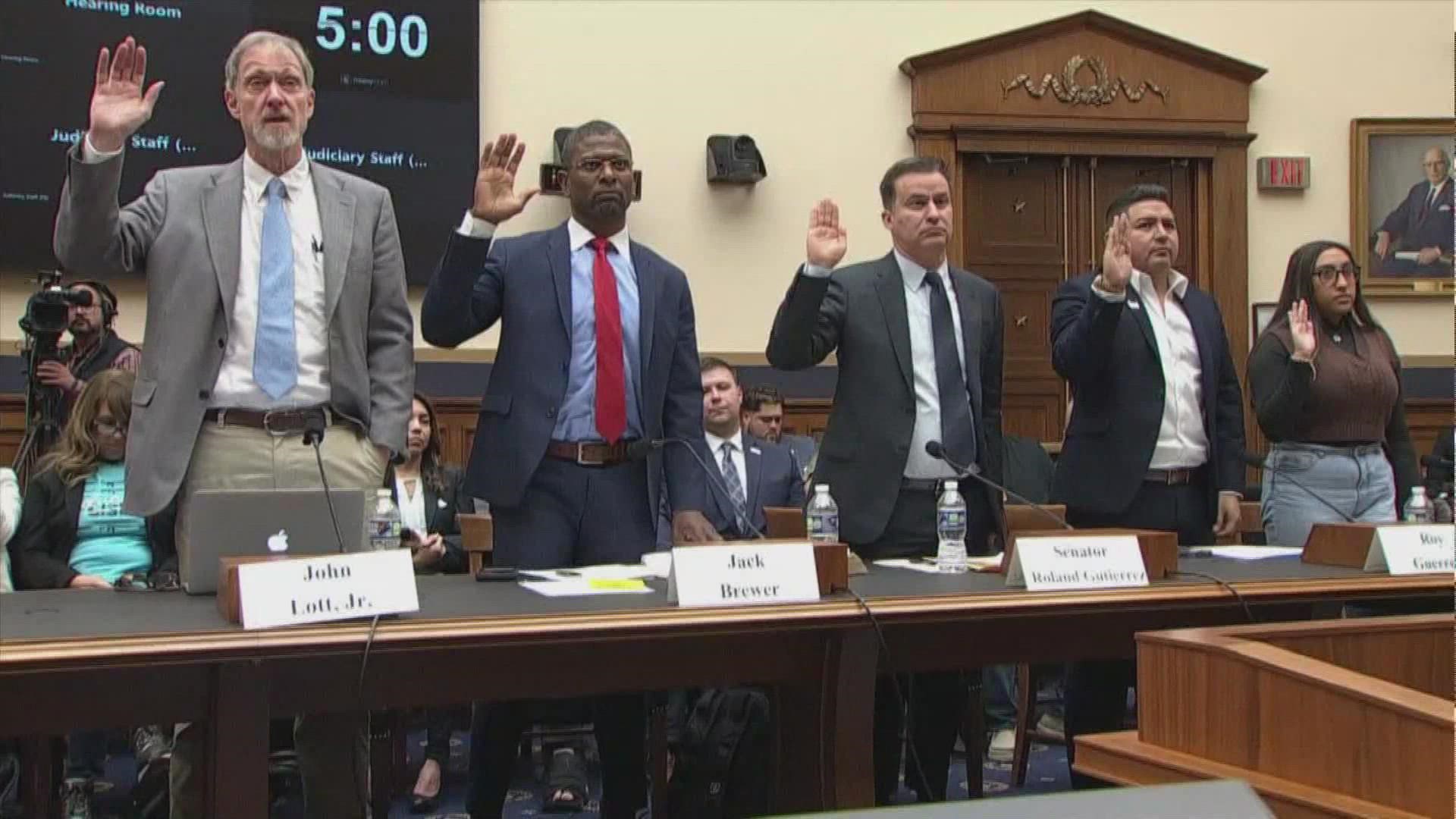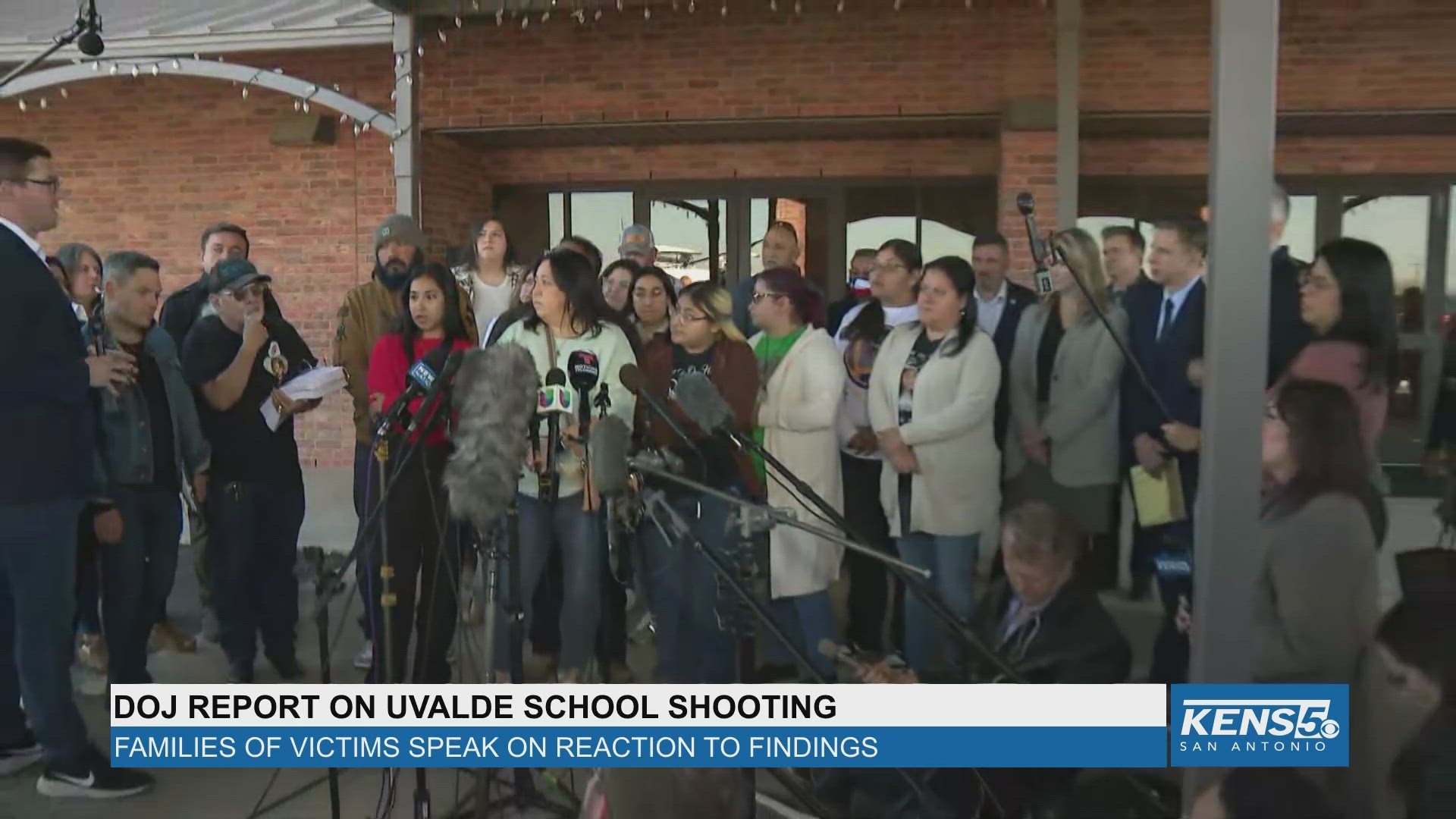UVALDE, Texas — A federal report into the law enforcement response to the mass shooting at Robb Elementary in Uvalde found multiple failures of law enforcement and concluded the massacre could have been stopped sooner with better training and decision-making skills of officers.
The report, which was released Thursday morning, revives scrutiny into the actions of the hundreds of officers who responded to the massacre but waited more than an hour to confront and kill the gunman.
The community of Uvalde continues to try to heal from the killing of 19 elementary students and two teachers as questions continue on the accountability of the officers' actions on May 24, 2022.
“In summary, the response to the May 24, 2022, mass casualty incident at Robb Elementary School was a failure," the report states. "The painful lessons detailed in this report are not meant to exacerbate an already tragic situation or further the pain and trauma to those directly impacted by the events on May 24 and the subsequent days, weeks, and months.”
See the full 610-page report below:
In a news conference Thursday after the report was released, U.S. Attorney General Merrick Garland said the most crucial problem with the response happened when responding officers shifted their tactics from entering the classroom to waiting for reinforcements.
"Within minutes of arriving inside the school, officials transitioned from treating the situation as an active shooter to a barricaded subject situation," Garland said. "This was the biggest failure."
"This meant officials spent time negotiating with the subject, instead of confronting the subject," Garland continued. "And it meant the victims remained trapped with the shooter for more than an hour after the first officers arrived on scene."
The police response was one of many issues tackled by the exhaustive report.
"The chaos and confusion that defined the law enforcement response also defined the aftermath of the shooting. Some families were told their family members had survived when they did not. And families of victims struggled to receive services to recover from this shooting," Garland said.
Vanita Gupta, associate attorney general, also spoke about the aftermath of the attack.
"Parents received unclear and uncertain information on where to go to get updates. Families searching for their loved ones were sent to different places all across town, the high school, the civic center and the hospital," Gupta said. "Some of the findings are gut-wrenching."
She went on to criticize the messaging going out from officials during the aftermath, and she pointed out that misinformation spread by officials was never corrected.
"Inaccurate and inconsistent public information including social media posts and press conference made things worse," Gupta said.
One of the key findings of the report addresses the communication between different agencies. The report says, “On the day of the school shooting at Robb Elementary School, each PIO acted independently and failed to coordinate the public messaging aspect of the response.”
The report stressed the importance of having a unified command system in place before critical incidents occur. The report also establishes firmly the Uvalde CISD did have jurisdictional authority over the incident, which was something in question during the initial investigation.
The Justice Department was careful to clarify the report is a critical incident review, not a criminal investigation. The key findings were found through the review of more than 14,000 pieces of evidence including training logs, body cameras, CCTV footage, audio recordings, personnel records and manuals of operating procedure.
The review team visited Uvalde nine times for a total of 54 days in the town.
Key observations from the report
The report is divided into 11 “observations” and recommendations the department has to prevent those from happening in the future.
Below are some of the key findings:
- Observation: “Responding agencies lacked adequate related policies and, in most cases, any policy on responding to active attackers”
- Recommendation: The report says agencies should have a clear policy ahead of critical incidents, which is reviewed regularly and draws from state and national policies.
- Observation: “The MOU (memorandum of understanding) between UPD and UCISD PD that was active the day of the incident failed to adequately outline the expectations and authorities for a response to a mass violence event. The agencies failed to exercise the MOU, nor cross-train in preparation for a critical incident.”
- Recommendation: The report says these two linked agencies should have had a better understanding of what was expected from each.
- Observation: “UPD and UCSO appear to show budgetary and staffing shortages, which prevent training opportunities.”
- Recommendation: The report suggests that the two agencies could have combined resources and done multi-agency training, even with budget shortages. Building those relationships between the departments would have also helped in the response.
- Observation: “UCISD’s campus safety teams met infrequently, and annual safety plans were based largely on templated information that was, at times, inaccurate.”
Recommendation: The report says campus safety teams need to be very deliberate about their campus-specific plans and make sure they are reviewed regularly.
Mental health services
Another issue unique to this report is their investigation into the offerings of mental health services in the aftermath of the shooting.
"Another challenge was the volume of service providers that descended on Uvalde. While the overwhelming support was appreciated, the FAC/FRC and the community could not handle the substantial number of people who self-deployed," the report states.
The report went on to detail the choas and confusion of the temporary services, resulting in both overlaps of services and gaps in services for victims, their families and first responders.
"Concerns arose around the credentials and licensure of the unknown volunteers, coordination of services, and lack of adequate experience in responding to MCIs. In one case, a large service provider deployed to the community and after a couple of days had to leave due to the trauma their own staff faced by not being prepared for the grief and emotions in the community," the report also says.
Texas House committee investigation
Meanwhile, in the last year and a half since the shooting, multiple damning reports have placed blame on cowardice, lack of sufficient training, and incompetence for why police waited more than an hour to breach the classroom and subdue the 18-year-old gunman.
An 80-page report from a panel of state lawmakers and investigations by journalists in July of 2022 laid out how over the course of more than 70 minutes, a mass of officers went in and out of the school with weapons drawn but did not go inside the classroom where the shooting was taking place. The 376 officers at the scene included state police, Uvalde police, school officers and U.S. Border Patrol agents.
Texas Tribune Investigation
A Texas Tribune investigation in March of 2023, based on police body cameras, emergency communications and interviews with investigators that had not been made public, found officers had concluded that immediately confronting a gunman with an AR-15 would be too dangerous. Even though some officers were armed with the same rifle, they opted to wait for the arrival of a Border Patrol SWAT team, with more protective body armor, stronger shields and more tactical training — even though the unit was based more than 60 miles away.
"You knew that it was definitely an AR,” Uvalde Police Department Sgt. Donald Page said in an interview with investigators after the school shooting. “There was no way of going in. … We had no choice but to wait and try to get something that had better coverage where we could actually stand up to him.”
At least five officers have lost their jobs, including two Department of Public Safety officers and Uvalde’s school police chief, Pete Arredondo, who was the on-site commander during the attack.
'I hope the failures end today'
Meanwhile, 16 families who lost children at Robb, as well as one family whose child survived the shooting, secured legal counsel.
Parents made the announced while standing behind their new attorney, Josh Koskoff, on Thursday. The private attorney says he is evaluating potential legal action on behalf of these families as another means of trying to hold people accountable.
While various legal issues remain under consideration, Koskoff said the bigger picture revolves around figuring out how an 18-year-old was able to purchase so much firepower both at stores and online.
"Robb Elementary began the day an 18-year-old was allowed to purchase an AR-15," said Kim Rubio, who lost her daughter Lexi in the shooting.
The Uvalde families said they didn't need a 500-page government report to learn that law enforcement failed.
"Were they really afraid of this kid? No," Koskoff said, referring to police who responded to Robb. "They were afraid of his weapon."
Koskoff said the group's goal is for the government to take a closer look at the accessibility of military-grade weapons like AR-15s to 18-year-olds.
"He ordered over 1,700 rounds of ammunition from an online ammo dealer. How could that happen?"
Families say the DOJ report was the most comprehensive one they've seen to date.
A missing element they hoped to see, however, is analysis of the role that marketing for gun companies played. They continue pushing for gun reform, starting with raising the legal age to purchase a firearm to 21.
Families say they would have also liked to learn more information about DPS's role, and for the attorney general to address delays in the DA's investigation.
For several months, Uvalde County DA Christina Mitchell said her office is continuing to review evidence.


